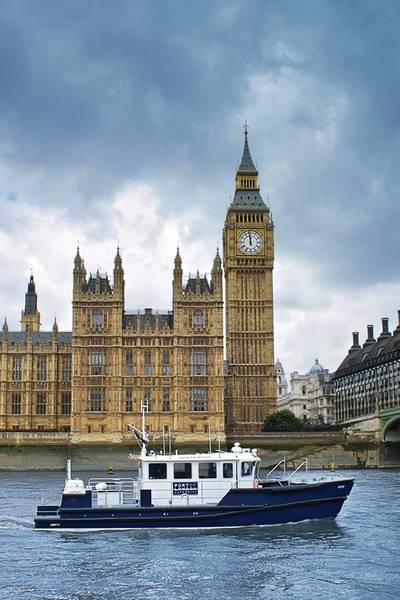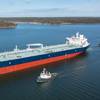Powering London’s Games
The Port of London Authority and John Deere worked together to keep London’s river Thames safe during the Olympics.
Thousands of spectators made their way along Putney Bridge, basking in the sunshine and soaking up the atmosphere. With the 2012 Olympics in London this summer, following on the heels of the Queen’s Diamond Jubilee pageant, the city had never been so vibrant. On the Thames, dozens of ships cruised along the waterfront, including a new range of patrol boats. Commissioned by the Port of London Authority (PLA) to keep London’s river safe, these vessels stayed on guard, casting a watchful eye on the huge Olympic crowds during the games.
Promoting safety on the river is the role that the PLA sees as highest priority for their innovative ‘Bridge Class’ of low-wash, low-emission patrol boats. Named after four of London’s famous bridges, Lambeth, Southwark, Kew and Barnes, the vessels were built by Alnmaritec Limited in collaboration with Newcastle University, but based on the PLA’s design concept. The vessels have been optimized to work on the tidal Thames, with a lightweight but strong 12 ton (11-metric ton) aluminum hull, and two powerful, fuel efficient John Deere PowerTech 6068T engines, rated at 201 hp (150 kW).
With two historical events held in the ever-busy city, this past summer, the fleet took on a vital role during the special celebrations. Supported by the PLA’s newly refurbished navigation control centers at Gravesend and Woolwich, where duty officers observe and report the movement of vessels using a sophisticated network of radar, AIS, VHF radio and other navigational systems, the new launches provided the “eyes and ears” of the Harbor Masters, out on the river. Designing the vessels took five years in all. From the start, the PLA was keen to use John Deere engines, which would deliver sufficient power while still maintaining their operating temperature using keel cooling. “This solution does not rely on sea or river water entering the engines for cooling, which is important because the silt-laden water of the Thames tends to block or damage cooling pumps and other systems,” said Alan Cartwright, the PLA’s head of marine engineering.
The project for design and build of the innovative vessels was put to open bid and won by Alnmaritec, which is known for providing specialized commercial vessels to clients’ demanding requirements. The engines were supplied by John Deere distributor E.P. Barrus Ltd, which conducts good business with both Alnmaritec and the PLA. “E.P. Barrus provided modifications to the exhaust manifold to prevent possible overheating of the engine, and – to the PLA’s electrical systems design for the vessels - fitted larger on-engine auxiliary generators, providing all 230V AC power via an inverter. This prevented the need for a separate main generator and saved weight – essential to vessel efficiency.”
Partnership Engineered for Success
Alnmaritec designed the vessels based on PLA’s concept drawing and detailed specification, which focused on using ecologically-sensitive, energy-efficient solutions. Specialists were called in to support the design process: the Marine Science Department of Newcastle University participated in the underwater form and propeller design, while specialist naval architects Amgram Limited optimized the vessel strength for minimum hull weight. The result was a 44 ft. (13.5m) deep-vee catamaran design, specifically tailored for navigational patrol and pilotage tasks along the river. The efficiency of the design is achieved through the combination of tremendous strength and seakeeping capability, at low displacement weight, efficient hull form with matched propellers and very slippery Intersleek silicone anti-fouling, from International Paints Ltd. With their two John Deere engines, they can achieve top speeds of around 20 knots.
The Lambeth was the first of class, built and used as a prototype, upon which the PLA crews, managers and engineers developed the design from lessons learned, in operational service. Southwark, Kew and Barnes were built to the redefined specification, which incorporated a number of operational improvements.
These included improved fendering, increased windscreen sizes, sliding wheelhouse doors, better instrumentation layout and revised alignment of the guardrails on the sides of the vessel, to help with pilotage operations. After two years in service, Lambeth was also refitted to the new specification.
Efficient – and Green, too
During the service of the four vessels so far, it has become clear that the operational efficiencies and advantages that were fundamental to the design concept have all been delivered. Compared to the older vessels being used in the same way, the new launches with John Deere engines use 52.4% less diesel fuel (based on aggregate monthly consumption). This is true even though the Bridge Class vessels in central London were put to particularly high use during the 2012 events and their preparation.
“The difference is particularly striking in the PLA’s Lower District, where patrol and pilotage savings are very significant,” explains Alan, “And don’t forget: exhaust emission levels are directly associated with fuel consumption, so these are reduced by some 50% as well, compared to older vessels in like-for-like service.” Alan also highlights the other savings from the new vessel class: “The new launches have provided greater operational availability and offer additional savings, in terms of maintenance and upkeep costs. The cost of ownership is reduced by some 28%, in comparison with the older vessels.”
Workboats
With the success of the PLA’s vessels, Alnmaritec has decided to market the design as the “Wave Guardian”. Such is the success of the design that they are building a range of catamaran vessels for other clients, using the same deep V-hull shape, from 44 ft. (13.5m) in length up to 59 ft. (18m).
Even with the summer 2012 festivities now a recent memory, the four vessels will be kept busy. “The crews who man these boats are the harbor masters’ eyes and ears on the river.
They work with our navigational control centers to help keep vessels on the river safe and to control river traffic, during major events such as New Year’s Eve fireworks. Southwark and Kew will patrol the river between Southend and Putney.
This stretch of river is used by everything from large container ships to sailing dinghies, commuter ferries to barges. And with more traffic than ever expected on the river, their role is crucial,” says PLA chief executive, Richard Everitt.
Among other duties, the vessels take part in traffic control during Thames closures for major engineering activity and special events; they help out in emergencies such as fires, groundings, or when a person goes overboard, as well as supporting other emergency services; assist small craft in difficulties; transport pilots from ship to shore; clear debris; and much more.
With so many tasks and responsibilities, the innovative, built-to-specification vessels will continue to be put to the test.
(As published in the November 2012 edition of Marine News - www.marinelink.com)














